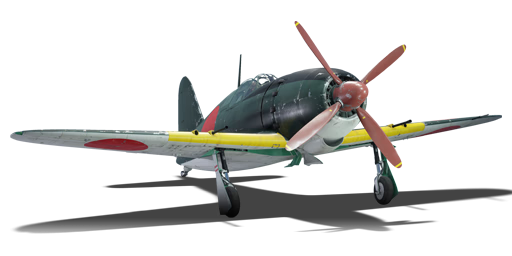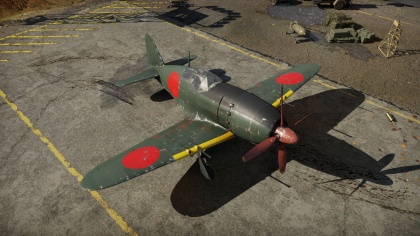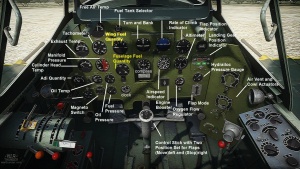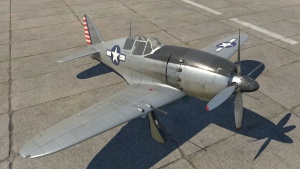Difference between revisions of "J2M3"
CobraKingII (talk | contribs) (→Flight performance) |
(→History) |
||
| Line 224: | Line 224: | ||
== History == | == History == | ||
<!-- ''Describe the history of the creation and combat usage of the aircraft in more detail than in the introduction. If the historical reference turns out to be too long, take it to a separate article, taking a link to the article about the vehicle and adding a block "/History" (example: <nowiki>https://wiki.warthunder.com/(Vehicle-name)/History</nowiki>) and add a link to it here using the <code>main</code> template. Be sure to reference text and sources by using <code><nowiki><ref></ref></nowiki></code>, as well as adding them at the end of the article with <code><nowiki><references /></nowiki></code>. This section may also include the vehicle's dev blog entry (if applicable) and the in-game encyclopedia description (under <code><nowiki>=== In-game description ===</nowiki></code>, also if applicable).'' --> | <!-- ''Describe the history of the creation and combat usage of the aircraft in more detail than in the introduction. If the historical reference turns out to be too long, take it to a separate article, taking a link to the article about the vehicle and adding a block "/History" (example: <nowiki>https://wiki.warthunder.com/(Vehicle-name)/History</nowiki>) and add a link to it here using the <code>main</code> template. Be sure to reference text and sources by using <code><nowiki><ref></ref></nowiki></code>, as well as adding them at the end of the article with <code><nowiki><references /></nowiki></code>. This section may also include the vehicle's dev blog entry (if applicable) and the in-game encyclopedia description (under <code><nowiki>=== In-game description ===</nowiki></code>, also if applicable).'' --> | ||
| − | + | {{main|J2M (Family)|l1=History of the J2M}} | |
| + | ===Development=== | ||
| + | During the China Incident (Sino-Japanese war) the Navy had sustained some damage from Chinese bomber groups as they didn't have any dedicated interceptors at the time, for this reason the Navy put out multiple specifications for planes to deal with threats which the Chinese made clear to the Navy. For bombers specifically they specified for a strictly local-defense interceptor known as the ''{{Annotation|14-Shi|14th year of the Showa reign, 1939}} Interceptor''. | ||
| − | The | + | The designer behind the [[A6M (Family)|A6M]], Jiro Horikoshi and his team started development on this specification. But due the harsh unrealistic specifications for mainly engine output required for the team to use a strong engine which wasn't available yet and with the oversized engine required for the task resulted in a sleek but stubby plane. |
| − | + | After the initial J2M1 prototypes outfitted with the {{Annotation|1,044 kW|1,400 hp}} Mitsubishi MK4C ''Kasei 13'' 14-cylinder air-cooled radial engine and didn't come near the specification requirements, engine vibrations coming from the cooling system and a troublesome undercarriage design held it back from being used as a production model. | |
| − | The | + | The [[J2M2|J2M2 Model 11]] was outfitted with {{Annotation|1,379 kW|1,850 hp}} Mitsubishi MK4R-A ''Kasei 23a'' 14-cylinder radial engine which somewhat overcame the teething problems but still didn't reach the requirements, overburdened with engine problems and electrical malfunctions in the landing gear remained. |
| + | |||
| + | Mitsubishi wanted to make the best of it and get out the J2Ms into combat service before it was officially adopted in the Navy. Engine problems and performance were only further resolved in further modifications. | ||
| + | |||
| + | The [[J2M3|J2M3 Model 21]] was developed parallel with the [[J2M2|J2M2 Model 11]] with improved armament of four 20 mm Type 99's in the wings (two [[Type 99 Model 1 (20 mm)|Model 1]]s and two [[Type 99 Model 2 (20 mm)|Model 2]]s). | ||
| + | |||
| + | ===Combat History=== | ||
| + | Production of the [[J2M3|J2M3 Model 21]] was parallel with the [[J2M2|J2M2 Model 11]] and the first [[J2M3]]s appeared in October 1943 but deliveries to combat units started at the beginning of February 1944. | ||
| + | |||
| + | Furthermore, the [[J2M2]] and [[J2M3]] saw limited action in the Philippines, although it was largely ineffective due to the limited initial production batch and design flaws. | ||
== Media == | == Media == | ||
Revision as of 04:42, 14 October 2020
Contents
| This page is about the Japanese fighter J2M3. For other versions, see J2M (Family). |
Description
The J2M3 Raiden is a rank IV Japanese fighter
with a battle rating of 6.3 (AB), 5.7 (RB), and 5.0 (SB). It was introduced in Update 1.45 "Steel Generals".
Unlike its other Naval brethren in the Japanese tech tree, the Raiden possesses a top speed rivalling that of the P-51 D-5 Mustang. Although a stubby and small aircraft, the Mitsubishi J2M Raiden can be considered one of the best Japanese fighters in War Thunder. Wielding four 20 mm cannons, this aircraft can spell death for any enemy it encounters. However, the main advantage the Raiden has over its Allied counterparts is its climb rate. In realistic battles, the J2M3 can climb to altitude very fast, especially when given an air start. Once at a high altitude, the Raiden pilot can pick and choose targets, dictating where and when they want to fight. The J2M3's 20 mm cannons may seem lacklustre at first, but they have a knack for snapshots or quick bursts of fire that result in a kill when manoeuvring. Generally, the J2M3 performs similarly to the early Fw 190 A variants, having a deadly armament, good roll rate, low top speed, but higher climb rate. Use what the Raiden does best to achieve success - energy fighting. This aircraft is not built for turn-fighting and when does, will lose all built up energy or speed in turns. Attack enemies from a higher altitude and then regain that altitude once the attack has been delivered. The J2M3 excels at Boom & Zoom attacks due to its high rate of climb and deadly armament.
The Raiden aircraft's main downside is its lack of manoeuvrability at higher speeds. Similar to its German counterpart, the Fw 190 A-8, the Raiden struggles to beat enemies in turn fights, especially Spitfires although one shouldn't turn with a Spitfire in general. If caught in a sticky situation, the Raiden pilot may choose to dive away or seek help from teammates. Trying to fight an enemy Spitfire in a turn battle with the J2M is a terrible idea unless the enemy aircraft is damaged or many teammates are nearby. Moreover, the J2M's high-speed manoeuvrability is poor, making the entire aircraft lock up. It can be very difficult to pull out of a dive, roll, or turn when at high speeds with the J2M. The Raiden's manoeuvrability is more or less on par with its enemies in simulator battles, for the most part.
General info
Flight performance
| Characteristics | Max Speed (km/h at 5,500 m) |
Max altitude (metres) |
Turn time (seconds) |
Rate of climb (metres/second) |
Take-off run (metres) | |||
|---|---|---|---|---|---|---|---|---|
| AB | RB | AB | RB | AB | RB | |||
| Stock | 571 | 551 | 11500 | 19.8 | 20.5 | 16.0 | 16.0 | 300 |
| Upgraded | 625 | 596 | 18.8 | 19.0 | 28.5 | 21.3 | ||
Details
| Features | ||||
|---|---|---|---|---|
| Combat flaps | Take-off flaps | Landing flaps | Air brakes | Arrestor gear |
| ✓ | ✓ | ✓ | X | X |
| Limits | ||||||
|---|---|---|---|---|---|---|
| Wings (km/h) | Gear (km/h) | Flaps (km/h) | Max Static G | |||
| Combat | Take-off | Landing | + | - | ||
| 0 | 350 | 515 | 515 | 280 | ~11 | ~8 |
| Optimal velocities (km/h) | |||
|---|---|---|---|
| Ailerons | Rudder | Elevators | Radiator |
| < 390 | < 400 | < 420 | > 324 |
| Compressor (RB/SB) | ||
|---|---|---|
| Setting 1 | ||
| Optimal altitude | 100% Engine power | WEP Engine power |
| 2,203 m | 1,680 hp | 1,999 hp |
| Setting 2 | ||
| Optimal altitude | 100% Engine power | WEP Engine power |
| 5,400 m | 1,560 hp | 1,856 hp |
Survivability and armour
- 70 mm Bulletproof glass - Armoured windscreen
- 8.5 mm Steel plate in pilot's headrest
Armaments
Offensive armament
The J2M3 is armed with:
- 2 x 20 mm Type 99 Model 2 cannons, wing-mounted (210 rpg = 420 total)
- 2 x 20 mm Type 99 Model 1 cannons, wing-mounted (190 rpg = 380 total)
Suspended armament
The J2M3 can be outfitted with the following ordnance:
- Without load
- 2 x 60 kg Navy Type 97 Number 6 bombs (120 kg total)
- 2 x Type 3 No.1 Mod.28 Mk.1 rockets
- 2 x Type 5 No.1 Mod.9 rockets
- 2 x Type 3 No.6 Mod.27 Mk.1 rockets
- 2 x Type 5 No.6 Mod.9 rockets
Usage in battles
Featuring two 20 mm Type 99 Model 1 cannons and two 20 mm Type 99 Model 2 cannons with plenty of ammunition, the J2M3 is capable of destroying all kinds of aircraft. Although destroying heavy bombers like the B-29 Superfortress takes a lot of ammunition, the J2M3 can afford to lose some. The "Stealth" belt has the best combination of AP/API and HEF to shred enemy aircraft and are recommended for those who do not need a tracer shell to aim. Alternatively, for those not used to IJN 20 mms, the "Universal" belt is your best bet. The "Tracer" belt is filled with HEF-T shells, but they only contain half of the power of a standard HEF, and can give away your position.
For ground attack, the J2M3 can equip two 60 kg bombs under the wings. While not the biggest, these bombs can help a team win a match, especially in arcade battles. The J2M3 can also wield armour piercing ground targets ammunition for its 20 mm cannons, although 21 mm of penetration is nothing to boast about and should be ignored unless targeting armoured personnel carriers (APC) or similar armoured cars.
Overall, the Raiden is best used as a surprise attack, high altitude, high damage output fighter. While it does not excel in the speed or manoeuvrability categories, it makes up for that in armament and rate of climb.
The Raiden pilot may also find themselves outclassed by high altitude aircraft such as the P-51D-5 Mustang. All these aircraft have to do to avoid the J2M is dive away and build up speed, but the J2M3 can generally outturn them with effective use of combat flaps and rudder. Fortunately, the J2M3 has a surprise - a massive ammunition pool totalling 800 rounds. That's 800 rounds of high explosive cannon ammunition that can be dispensed at will towards fleeing enemies. With good aim and practice, it is possible to "snipe" enemies from a kilometre away.
Manual Engine Control
| MEC elements | ||||||
|---|---|---|---|---|---|---|
| Mixer | Pitch | Radiator | Supercharger | Turbocharger | ||
| Oil | Water | Type | ||||
| Controllable | Controllable Not auto controlled |
Controllable Not auto controlled |
Controllable Not auto controlled |
Separate | Controllable 2 gears |
Not controllable |
Modules
| Tier | Flight performance | Survivability | Weaponry | |||
|---|---|---|---|---|---|---|
| I | Fuselage repair | Radiator | Offensive 20 mm | Type 3 No.1 Mod.28 Mk.1 rockets | ||
| II | Compressor | Airframe | Offensive 20 mm | Type 5 No.1 Mod.9 rockets | ||
| III | Wings repair | Engine | New 20 mm cannons | Type 3 No.6 Mod.27 Mk.1 rockets | ||
| IV | Engine injection | Cover | New 20 mm cannons | Type 5 No.6 Mod.9 rockets | ||
- Unlocking all performance modules should be a Raiden pilot's first concern, as the default belts for all weapons are workable. After that, go for the weapon belts, as these make more targets possible (ground units).
Pros and cons
Pros:
- Decent top speed, although lower than its contemporaries
- Large ammunition pool
- Insanely high climb rate
- Has generally adequate dive characteristics
- Quite excellent energy retention
- Great medium-speed manoeuvrability
- 12 mm armour plate behind the windscreen
- Reasonable roll rate at lower speeds
- Solid armament layout
- Excellent performance at high altitudes
Cons:
- Very poor high-speed performance
- Prone to engine and fuel fires
- Doesn't turn well at higher speeds
- Elevator doesn't respond well, especially at high speeds
- Lack of armour around fuel tanks or engine
- Differing muzzle velocities between the two models of the Type 99 cannon on the J2M3 will require you to lead much further than normal as an order to utilize the full effectiveness of the J2M3's firepower
History
Development
During the China Incident (Sino-Japanese war) the Navy had sustained some damage from Chinese bomber groups as they didn't have any dedicated interceptors at the time, for this reason the Navy put out multiple specifications for planes to deal with threats which the Chinese made clear to the Navy. For bombers specifically they specified for a strictly local-defense interceptor known as the 14-Shi Interceptor.
The designer behind the A6M, Jiro Horikoshi and his team started development on this specification. But due the harsh unrealistic specifications for mainly engine output required for the team to use a strong engine which wasn't available yet and with the oversized engine required for the task resulted in a sleek but stubby plane.
After the initial J2M1 prototypes outfitted with the 1,044 kW Mitsubishi MK4C Kasei 13 14-cylinder air-cooled radial engine and didn't come near the specification requirements, engine vibrations coming from the cooling system and a troublesome undercarriage design held it back from being used as a production model.
The J2M2 Model 11 was outfitted with 1,379 kW Mitsubishi MK4R-A Kasei 23a 14-cylinder radial engine which somewhat overcame the teething problems but still didn't reach the requirements, overburdened with engine problems and electrical malfunctions in the landing gear remained.
Mitsubishi wanted to make the best of it and get out the J2Ms into combat service before it was officially adopted in the Navy. Engine problems and performance were only further resolved in further modifications.
The J2M3 Model 21 was developed parallel with the J2M2 Model 11 with improved armament of four 20 mm Type 99's in the wings (two Model 1s and two Model 2s).
Combat History
Production of the J2M3 Model 21 was parallel with the J2M2 Model 11 and the first J2M3s appeared in October 1943 but deliveries to combat units started at the beginning of February 1944.
Furthermore, the J2M2 and J2M3 saw limited action in the Philippines, although it was largely ineffective due to the limited initial production batch and design flaws.
Media
- Skins
- Images
- Videos
See also
Links to the articles on the War Thunder Wiki that you think will be useful for the reader, for example:
- reference to the series of the aircraft;
- links to approximate analogues of other nations and research trees.
External links
Paste links to sources and external resources, such as:
- topic on the official game forum;
- encyclopedia page on the aircraft;
- other literature.
| Mitsubishi Company (三菱商会) | |
|---|---|
| Fighters | A5M4 · Hagiri's A5M4 |
| A6M2 mod. 11 · A6M2 · A6M3 · A6M3 mod. 22 · A6M3 mod. 22Ko · A6M5 · A6M5 Ko · A6M5 otsu · A6M5 Hei · A6M6c | |
| A7M1 (NK9H) · A7M2 | |
| J2M2 · J2M3 · J2M4 Kai · J2M5 · J2M5 (30 mm) | |
| Hydroplanes | F1M2 |
| Interceptors | Ki-83 · Ki-109 |
| Bombers | G4M1 |
| Ki-21-Ia · Ki-21-I hei · Ki-67-I Ko · Ki-67-I otsu | |
| Jet Fighters | Ki-200 |
| Captured | ▃A6M2 · ␗A6M2 |
| See also | Mitsubishi Heavy Industries, Ltd. (Post-War) |
| Japan fighters | |
|---|---|
| Navy | |
| Carrier-based fighter | |
| A5M | A5M4 · Hagiri's A5M4 |
| A6M | A6M2 mod. 11 · A6M2 · A6M3 · A6M3 mod. 22 · A6M3 mod. 22Ko · A6M5 · A6M5 Ko · A6M5 otsu · A6M5 Hei · A6M6c |
| A7He | A7He1* |
| A7M | A7M1 (NK9H) · A7M2 |
| Land-based Fighter | |
| J2M | J2M2 · J2M3 · J2M4 Kai · J2M5 · J2M5 (30 mm) |
| J6K | J6K1 |
| J7W | J7W1 |
| N1K-J | N1K1-Ja · N1K2-J · N1K2-Ja |
| Fighter seaplane | |
| N1K | N1K1 |
| A6M-N | A6M2-N |
| Army | |
| Ki-10 | Ki-10-I · Ki-10-I C · Ki-10-II · Ki-10-II C |
| Ki-27 | Ki-27 otsu · Ki-27 otsu Tachiarai |
| Ki-43 | Ki-43-I · Ki-43-II · Ki-43-III otsu |
| Ki-44 | Ki-44-I · Ki-44-I 34 · Ki-44-II otsu · Ki-44-II hei |
| Ki-61 | Ki-61-I ko · Ki-61-I otsu · Ki-61-I hei · Tada's Ki-61-I hei · Ki-61-I tei · Ki-61-II Otsu Kai |
| Ki-84 | Ki-84 ko · Ki-84 otsu · Ki-84 hei |
| Ki-87 | Ki-87 |
| Ki-94 | Ki-94-II |
| Ki-100 | Ki-100 · Ki-100-II |
| Other countries | ▅F4U-1A · ▅P-51C-11-NT · ▅Bf 109 E-7 · ▅Fw 190 A-5 |
| *Imported designation of the He 112 (A6M was in development - A7M would take A7 designation after the cancelation of the A7He) | |







